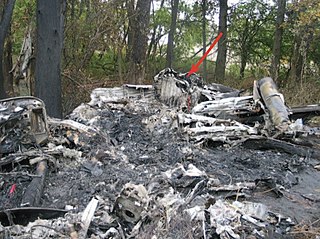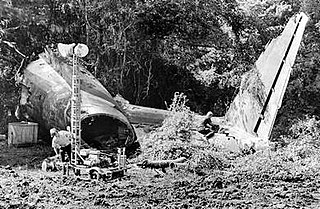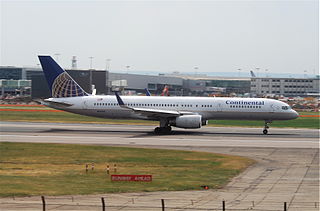
An aviation accident is defined by the Convention on International Civil Aviation Annex 13 as an occurrence associated with the operation of an aircraft, which takes place from the time any person boards the aircraft with the intention of flight until all such persons have disembarked, and in which (a) a person is fatally or seriously injured, (b) the aircraft sustains significant damage or structural failure, or (c) the aircraft goes missing or becomes completely inaccessible. Annex 13 defines an aviation incident as an occurrence, other than an accident, associated with the operation of an aircraft that affects or could affect the safety of operation.

Aviation safety is the study and practice of managing risks in aviation. This includes preventing aviation accidents and incidents through research, educating air travel personnel, passengers and the general public, as well as the design of aircraft and aviation infrastructure. The aviation industry is subject to significant regulation and oversight.

Corporate Airlines Flight 5966 was a scheduled passenger flight from St. Louis, Missouri to Kirksville, Missouri. On October 19, 2004, the Jetstream 32 aircraft operating the flight crashed on approach to Kirksville Regional Airport as a result of pilot error, killing 13 of the 15 people aboard.
An uncontrolled decompression is an undesired drop in the pressure of a sealed system, such as a pressurised aircraft cabin or hyperbaric chamber, that typically results from human error, structural failure, or impact, causing the pressurised vessel to vent into its surroundings or fail to pressurize at all.
In the U.S., Federal Communications Commission (FCC) regulations prohibit the use of mobile phones aboard aircraft in flight. Contrary to popular misconception, the Federal Aviation Administration (FAA) does not actually prohibit the use of personal electronic devices on aircraft. Paragraph (b)(5) of 14 CFR 91.21 permits airlines to determine if devices can be used in flight, allowing use of "any other portable electronic device that the operator of the aircraft has determined will not cause interference with the navigation or communication system of the aircraft on which it is to be used."

The Air Line Pilots Association, International (ALPA) is the largest pilot union in the world, representing more than 77,000 pilots from 43 US and Canadian airlines. ALPA was founded on 27 July 1931 and is a member of the AFL-CIO and the Canadian Labour Congress. Known internationally as US-ALPA, ALPA is also a member of the IFALPA.

In aviation, a non-towered airport is an airport without a control tower, or air traffic control (ATC) unit. The vast majority of the world's airports are non-towered. In the United States, there are close to 20,000 non-towered airports compared to approximately 500 airports with control towers. Airports with a control tower without 24/7 ATC service follow non-towered airport procedures when the tower is closed but the airport remains open, for example at night.

Eastern Air Lines Flight 212 was a controlled flight into terrain accident of a McDonnell Douglas DC-9 during approach to Charlotte Douglas International Airport in North Carolina. The incident occurred on September 11, 1974, killing 72 of the 82 people on board. The scheduled flight was from Charleston Municipal Airport to Chicago O'Hare, with an intermediate stop in Charlotte.
A near miss, near death, near hit, close call is an unplanned event that has the potential to cause, but does not actually result in human injury, environmental or equipment damage, or an interruption to normal operation.

Comair Flight 5191 was a scheduled United States domestic passenger flight from Lexington, Kentucky, to Atlanta, Georgia. On the morning of August 27, 2006, at around 06:07 EDT, the Bombardier Canadair Regional Jet 100ER crashed while attempting to take off from Blue Grass Airport in Fayette County, Kentucky, 4 miles west of the central business district of the city of Lexington.

A runway incursion is an aviation incident involving improper positioning of vehicles or people on any airport runway or its protected area. When an incursion involves an active runway being used by arriving or departing aircraft, the potential for a collision hazard or Instrument Landing System (ILS) interference can exist. At present, various runway safety technologies and processes are commonly employed to reduce the risk and potential consequences of such an event.

A runway safety area (RSA) or runway end safety area is defined as "the surface surrounding the runway prepared or suitable for reducing the risk of damage to airplanes in the event of an undershoot, overshoot, or excursion from the runway."

The Confidential Incident Reporting & Analysis Service (CIRAS), formerly the Confidential Incident Reporting & Analysis System, is a confidential safety reporting service for health, safety and wellbeing concerns raised by workers in the UK transport industry. It is funded by members and run independently, though is a wholly owned subsidiary of Rail Safety and Standards Board (RSSB). The service covers the following sectors: passenger and freight train operators, light rail, Network Rail and its suppliers, London Underground, and Transport for London (TfL) bus operators.

Continental Airlines Flight 1883 was a Boeing 757 that mistakenly landed on a taxiway at Newark Liberty International Airport on the evening of October 28, 2006. There were no reported injuries or damage, but the narrowly averted disaster was investigated by the National Transportation Safety Board, and caused the Federal Aviation Administration to reevaluate and modify air and ground safety procedures at and around Newark Airport.

On 22 December 2009, an American Airlines Boeing 737-800, operating American Airlines Flight 331 and carrying 148 passengers and six crew, overran runway 12 on landing at Kingston in poor weather. The plane continued on the ground outside the airport perimeter and broke apart on the beach, causing injuries.
A confidential incident reporting system is a mechanism which allows problems in safety-critical fields such as aviation and medicine to be reported in confidence. This allows events to be reported which otherwise might not be reported through fear of blame or reprisals against the reporter. Analysis of the reported incidents can provide insight into how those events occurred, which can spur the development of measures to make the system safer.

Scandinavian Airlines System Flight 901, was a scheduled international flight operated by the Scandinavian Airlines System, that overran the runway at its destination at John F. Kennedy International Airport on February 28, 1984. The flight, using a McDonnell Douglas DC-10, originated at Stockholm Arlanda Airport, Sweden, before a stopover at Oslo Airport, Gardermoen, Norway. All 177 passengers and crew members on board survived, although 12 were injured. The runway overshoot was due to the crew's failure to monitor their airspeed and overreliance on the aircraft's autothrottle.
The Aviation Safety Action Program (ASAP) is a US aviation proactive safety program. ASAP promotes safety by encouraging voluntary self reporting of safety occurrences and situations to the Federal Aviation Administration (FAA) certificate holder. The reports are analyzed to reduce hazards and focus training. Reporting is encouraged by providing the volunteer reporter protection from certificate action. ASAP forms a safety team between the FAA, the certificate holder (airline/operator), employee, and the operator's employee labor organization. Safety improvement occurs without discipline, encouraging further and continued hazard reporting.

Korean Air Flight 631 (KE631/KAL631) was a scheduled passenger flight from Incheon International Airport near Seoul, South Korea to Mactan–Cebu International Airport in Metro Cebu, Philippines. On October 23, 2022, the Airbus A330-300 operating this flight overran the runway while landing in Cebu due to hydraulic failure. Despite what reports described as a "terrifying close call," all passengers and crew members survived without injuries. However, the aircraft was damaged beyond repair and written off as a result of the accident, making it the 14th hull loss of an Airbus A330.

Bobbie R. Allen was a U.S. Government Official, Air Safety Investigator and Naval Aviator. After four years as Director of the Bureau of Aviation Safety at the Civil Aeronautics Board, and the NTSB, the airlines of the world had the best safety record in their history and United States scheduled carriers had their best safety record since 1954.















